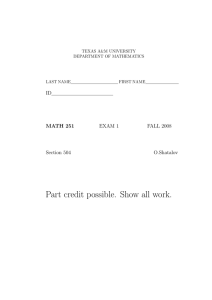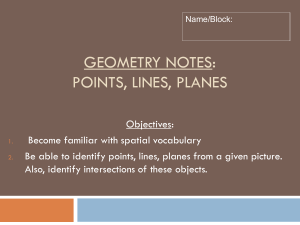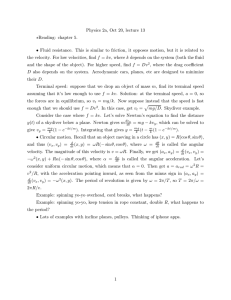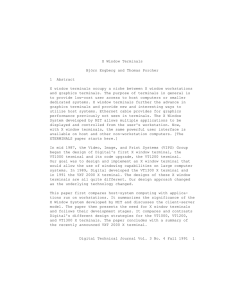p 1ST IB TE
advertisement
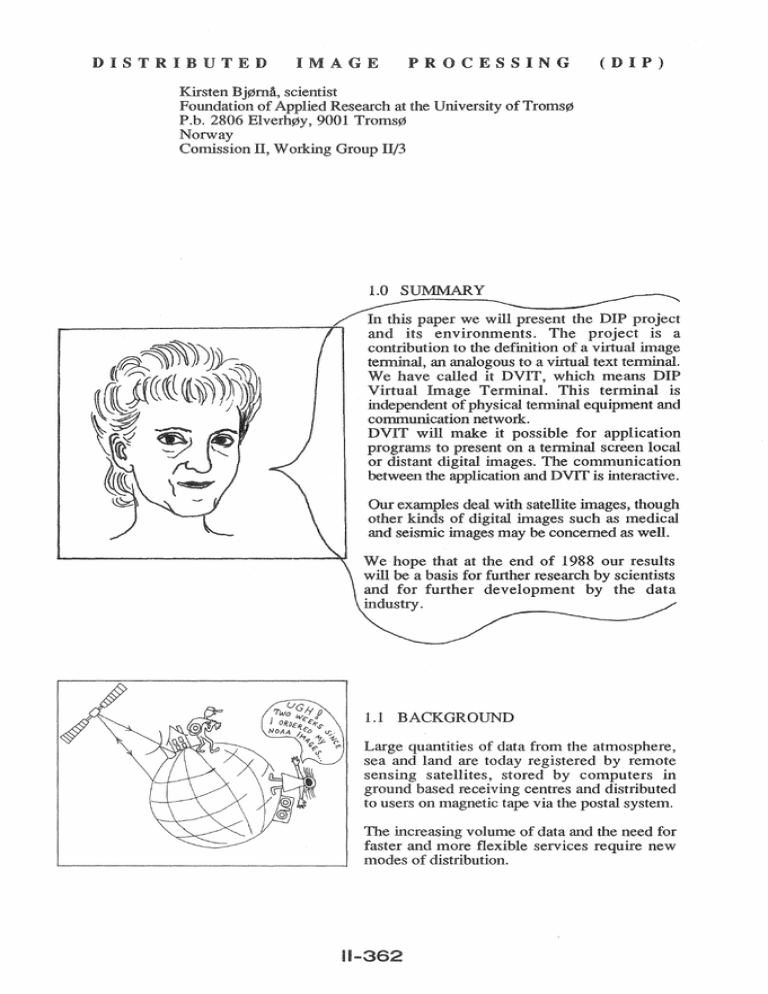
1ST
IB
TE
I
E
p
(
CESSING
a
I p)
a
image
text tenninal.
is
cmnnluruc,ttlGtn network.
DVIT will make it possible for application
.....-r.-..n--w·<!ll-n--." to
on a
screen local
images. The communication
the application
DVIT is interactive.
....... ...,... " ......
U.Jlf", ..... ,......_
with satellite images, though
A"'""' such as tnedical
1 -n--..an-~·" may be concerned as well.
u ...;::;, ..... UJ.
..............
at
end of 1988 our results
for further research by scientists
developtnent by the data
1.1 BACKGROUND
of data from
atmosphere,
are today registered by remote
satellites, stored by computers in
receiving centres and distributed
to users on magnetic tape via
postal systetn.
-:lnv·tTt~"C'
volume of data and the need for
and tnore flexible services require new
distribution.
tnf"'T'~-::1~" 111'n-
1.2 FUTURE USERS
A brief investigation has been carried out
among users
Norway by the
project
group. Some fields
require fast distribution
were identified :
1. Wave and stream forecasting for offshore
industry during critical installations.
Pollution detection.
3. Observation of the c:-nr..-."'1.,.,.""''•r1n
mountains so that water
can be
adjusted to avoid damage caused by . . . .....,,., . . . .,.
4. Monitoring of the ice cover and
edge
scientific expeditions.
5. Monitoring of sea surface temperatures
fish fanning.
6. Detection of
ships by
coastguard.
1.3 VISION
Imagine that image terminals are spread all over
the world, with connections to distant databases
and satellite image aquisition stations via highspeed data networks.
the terminals the
users may ask
a complete image, parts of
an image, data compression, preprocessing, or
encryption, as well as an estimate of the
processing and communication costs to allow
them to abort the transfer if it is too expensive.
The terminals are of all cathegories from low
cost Personal Computers to advanced image
workstations or computer mainframes.
1.4 DVIT
PIECE OF A PUZZLE
the vision to becotne a reality, several
pieces of a puzzle have to be put together :
1.
2.
3.
4.
Digital image databases.
High-speed telecotrununications.
Virtual image terminals.
User applications interfaced to
the virtual image terminals.
Virtual Image Terminal, belongs
DVIT, the
to this puzzle.
1.5
1.
a
2.
1
is
by
Norwegian Cooocil
Scientific and
nrh,~<lf"ll" 1 "ll•
Research Division
of the
Telecommunications
manyears,
1988.
1.7
the two research
and
Oslo, are
Ima.1lg
Input
Unit
Image
1' resento.tlon
Untt
/ • o• tu>o
oe/
/
7
Bi110.~ Signa.llln~UnLt
F"UnctioMl11'1pu..t
Unlt
L-----'1:----/
'l'exiln put UnLt
GraphicaUnpui Unit
main parts:
is a
into
of any size are placed.
'"''-"~... "' ......... of several itnage planes and
the users point of view
the storage appears as a
printed
photographs on it, where the photographs tnay
overlap each other.
This model is suitable for satellite images
consisting
image planes, one per
measuring instrument channel.
The graphical planes may be useful for drawing
grids, text etc. to be overlayed the images.
......................... UY\'.110'<"""
2.3 WINDOW CON1ROL STORAGE
i~
I
::
~~~ Se~"een
~
"""
meh'\Ot-'1.{
" '~~---.,,->---~,.
'
I
I
0
I
I
:
I
Imu.ge
])es~
lop
IIY\a.ge i
The Window Control Storage completely
controls what is shown on the image screen. Its
functions could be compared to a lens with
colour filters through which the user looks at
the Images on the Image Desk Top. The lens
can give magnification or reduction, the filters
can give colours or grey level representation.
The Window Control Storage is divided into a
set of Windows. From the users point of view,
each window can have its own lens, can be
moved around on the screen and on the Image
Desk Top, can be changed
size and can
overlap other windows.
2.4 DVIT OPERATIONS
))V iT
OPERAT i 0 NS:
A P P LiCAri ON
Rea.dbVi'rCC!fO-ln.LLtle.s
COftJ.&LLdj List
:DviT
Dvi'Y
DVIT will offer a set of operations to an
application. If we concentrate on the Itnage
Presentation Unit, omitting the other DVIT
units, these operations are acting on the Image
Desk Top, the Cursor Storage and the Screen
Memory.
Thus, an interactive communication is enabled
between DVIT and the application. For
example, the application may order transfer of
image planes or graphical planes to the Image
Desk Top, tnovements of Windows on the
image screen, selection of Cursors to be
used,and presentation of Images in various
colour representations and magnifications on
the image screen. DVIT responds by executing
the orders and returning proper parameters to
the application.
Let us examine two of the operations :
2.5 OPERATION ReadDVITCapabilities
It is important that the application may take into
account whether the physical tenninal is
advanced or simple or something in between.
If an application asks for the service
readDVITCapabilities, this activates DVIT to
make available the list of capabilities of the
actual physical terminal. An exatnple is the
maxhnum number of image planes and
graphical planes allowed on the Image Desk
Top. (The Capability list is set up once for all
when DVIT is installed at the physical
terminal.)
11-366
~'···
·-·-'L"-
APPliCATiON
hhieiMseTrnnsei de..nti..JLeY
DVil
has to execute a file
to
description is found in the report
"Distributed Image Processing" by Bj¢rna,
Skogseth and Buvang;
as mentioned, is to
tenninal
on a
unplt:~m~en1:atllon consists of two processes,
that is, two different programs running
DVIT library
the DVIT
server.
communicate by means of the
DVIT protocol and may therefore
separated
physically
a data network when
physical
image
is to be a
offering
well defined operations,
when the
application asks
the operations, the library
handles
over to the server for execution.
The communication between the server and the
library is described by the DVIT protocols,
containing
ordered service, paratneters,
error messages etc ..
The
Desk
is located at the server
side in
.................. .Ll.~. ... .~..o:..... itnage data transfer
UJ.l:HU.J.A'-
I'P C
DViT
Se ~"tr42-r'
TERMINAL
T-~~APPLiGA~io~
]) v i I L~lrr--a.tv
IPC
An application has to
to test
DVIT.
Window System (from
NHllssa.cnraset:ts
JL'~""""""' of Technology, USA)
to
the
A.AAIJ ..
3.3
APPl-iCATiON
IMAGE TERMINAL
source
is far away
the terminal,
DVIT library and the server
physically separated and ""'""'..........,..., . . .,...
~
a telecommunication network. Recall
protocols ..........,.................. . .
the DVIT library communication.
chosen 64 kbit/s earthbound n.ot-·nrru•!r
as a
step, and 2Mbit/s satellite link as a
second step. TCP/IP communication protocols
(Transmission Control Protocols/Internet
Protocols)
be used to connect the two
computers, each
connected to an
Ethernet local network.
.........vo..& .........
s
I
<)
i3k
4.2 lMAGE PROCESSING
WORKSTATIONS
DViT LL~ro..rj
DViTsertr~r'
Ima..se
P!"'oc.eSSLn.3
Wor'lt3taiton.
DVIT and Image Processing Workstations
seem to have several functions in common.
Both present images on a screen.
Nevertheless they are of a different nature.
The main purposes of Image Processing
Workstations are to process and manipulate
local images and present them on the screen.
DVIT, on the contrary, is a proposal to a
standard virtual image terminal.
However, it might be an interesting and
important task to adapt image processing
applications to
This would
the
users to inspect distant images by means of
DVIT, and then make local image processing
(contrast enhancements, classifications, Fourier
Transforms, etc.) by the image processing
applications, provided that the images are
stored locally.
This is of course beyond the scope of the DIP
project in 1988.


